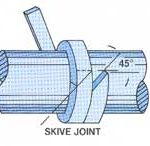Packing the Pump Correctly
The importance of packing the pump correctly cannot be overemphasized. Many packing failures are due to incorrect installation of the packing. The following steps have been devised to ensure effective installation of packings on pumps:
1) Remove all the old packaging from the stuffing box. Clean box and shaft thoroughly and examine shaft or sleeve for wear and scoring. Replace shaft or sleeve if wear is excessive.
2) Use the correct cross-section of packing or die-formed rings. To determine the correct packing size, measure the diameter of the shaft (inside the stuffing box area if possible) and then measure the diameter of the stuffing box (to give the OD of the ring). Subtract the ID measurement from the OD measurement and divide by two. The result is the required size.
3) When using coil or spiral packing, always cut the packing into separate rings. Never wind a coil of packing into a stuffing box. Rings can be cut with buff (square), skive (or diagonal) joints, depending on the method used for cutting. The following illustration shows these methods of preparing bulk packing. The best way to cut packing rings is to cut them on a mandrel with the same diameter as the shaft in the stuffing box area. If there is no shaft wear, rings can be cut on the shaft outside the stuffing box.
Hold the packing tightly on the mandrel, but do not stretch. Cut the ring and insert it into the stuffing box, making certain it fits the packing space properly. Each additional ring can be cut in the same manner, or the first ring can be used as a master from which the balance of the rings are cut. It is necessary that the rings be cut to the correct size. Otherwise, service life is reduced. This is where die-cut rings are of great advantage, as they give you the exact size ring for the ID of the shaft and the OD of the stuffing box. There is no waste due to incorrectly cut rings.
If the butt cut rings are cut on a flat surface, be certain that the side of the master rings, and not the OD or ID surface, is laid on the rings to be cut. This is necessary so that the end of the rings can be reproduced.
When cutting diagonal joints, use a miter board so that each successive ring can be cut at the correct angle. It is necessary that the rings be cut to the correct size. Otherwise, service life is reduced. This is where die-cut rings are of great advantage, as they give you the exact size ring for the ID of the shaft and the OD of the stuffing box. There is no wasted due to incorrectly cut rings.
4) Install one ring at a time. Make sure it is clean and has not picked up any dirt in handling. Seat rings firmly (except PTFE filament and graphite yarn packings, which should be snugged up very gently, then tightened gradually after the pump is operating). Joints of successive rings should be staggered and kept at least 90 degrees apart. Each individual ring should be firmly seated with a tamping tool, or suitable split bushing fitted to the stuffing box bore. When enough rings have been individually seated so that the nose of the gland will reach them, individual tamping should be supplemented by the gland.
5) After the last ring is installed, take up gland bolts finger tight or very slightly snugged up. Do not jam the packing into place by excessive gland loading. Start pump and take up gland bolts until leakage is decreased to a tolerable minimum. Make sure gland bolts are taken up evenly. Stopping leakage entirely at this point will cause the packing to burn, harden, and damage equipment.
6) Allow packing to leak freely starting up a newly packed pump. Excessive leakage during the first hour or operation will result in a better packing job over a longer period of time. Take up gradually on the gland as the packing seats, until leakage is reduced to a tolerable level, preferably 8-10 drops per minute, per inch of shaft diameter. Some packing can run virtually leak free. Contact your packing manufacturer for specific recommendations.
7) When specified by the pump manufacturer, provide means of lubricating the shaft and packing through the lantern ring by supplying water, oil, grease, or liquid handled in the pump. Fittings for this purpose are standard on many pumps. Flush pressure should be minimum 15 psi (1 bar) above stuffing box pressure.

8) If the stuffing box has a lantern ring (See Figure 5), make sure that the lantern ring is installed properly so it will remain under the inlet as gland pressure is applied.
9) Replace packing when leakage cannot be controlled by further take-up on the gland. Do not add more packing rings.
10) On both centrifugal and reciprocating pumps, about 70% of wear is on the outer two packings nearest the gland. However, each additional ring does throttle some fluid pressure. On most pumps, there must be enough rings so if one fails, another does the sealing, and the pump need not be shut down.

The mechanical pressure curve above shows eight packing rings. The first five do the majority of the sealing. The bottom three do little sealing, but are needed to fill the available space. The advantage of using fewer rings is less shaft or sleeve wear. Also, the stuffing box design is simpler and takes less material. But, wear isn’t the only problem. With high temperatures, high pressures, corrosive chemicals, or abrasive particles in the fluid, more rings may be the only solution for some services. In such cases, the bottom ring controlling the fluid may have the most wear from these severe service conditions.
Caution: All Packings must be installed in accordance with manufacturer’s instructions.


